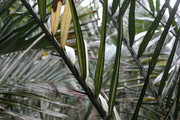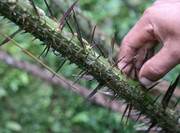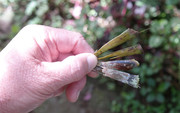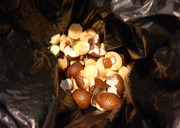We got to try a few different types at the farm. He did not have gula pasir (means "sugar sand" -- I guess grains of sugar?). I did get this at a roadside stand and as I reported earlier, gula pasir was quite sweet as far as salak go and fruity. I don't recall any sourness or astringency in gula pasir.
The one variety he had enough of to sell was nenas or nanas (means pineapple). This one was sweet with some sour (like pineapple) and smelled and tasted reminiscent of pineapple; it also had some slight astringency but not at all annoying.
We also tried kelapa (means coconut). This one was also sweet with some sour and also a slight astringency. There was a slight coconut essence to it -- I think if you didn't
know it was supposed to taste like coconut, you might miss it at first. I think this fruit was on the young side, perhaps the coconut would be more pronounced if perfectly ripe.
We also tried gondok. This one was supposed to have an aroma like a tropical magnolia. I am not sure what a tropical magnolia smells like but I wasn't detecting anything flowery about the aroma. It had a mixture of sweet with sour -- I made a note it was similar to nenas but without the pineapple essence. I found them all to be pleasant and to be "keepers".
It is interesting to note of the 4 varieties of Bali salak we tried, none had three seeds / fruit. Most had two seeds and some had only a single seed.
There was one other variety of salak we took note of, even though there were none to taste. It is a variegated variety called sudamala. I had not seen this variety recorded when I did my research. The farmer commented it tasted similar to some of the others, basically sweet with some sour aspect.
It is interesting to note that locals on both Java & Bali thought only a few varieties were being grown in the area. I suppose that those were the most common (commercially) -- I guess it would be like if you asked the average American how many varieties of apples there are. I am sure most would be hard pressed to name 6 when there are easily many dozens of varieties of apples.
We tried to moderate our tasting and limit ourselves to maybe 6 salak max / day. I had read prior that, while excess of most fruit will give you diarrhea, salak has the opposite effect. Everyone we talked to on both Java & Bali confirmed this. In fact the chef at the timeshare mentioned he like to keep some salak around to help guests who get diarrhea.
Again, upon checking fruit markets, I didn't see anything we didn't already have in HI.
A final comment, I missed wani (Mangifera caesia) season -- it was a couple of months earlier but I got the impression if I had been a month earlier, I might have run into some. Although research indicated that they also have M. caesia on Java, a worker at the timeshare originally from Solo indicated that they did not have it there. Another worker also indicated that when wani is perfectly ripe, it has already started to ferment & the alcohol will make you sleepy.
Pics below include:
- a line up of clones we tried
- a picture of the variegated salak plant, sudamala
- salak have some flattened "tab-like" spines along with the sharp spines
- a comparison of the dark tabs most salak have and the lighter green tabs of putih and gula pasir
- many salak have red flowers (nenas pictured), some (I think he again mentioned putih & gula pasir) have white flowers
- with lots of fruit to process for seeds, some was being discarded until the chef expressed interest in it







